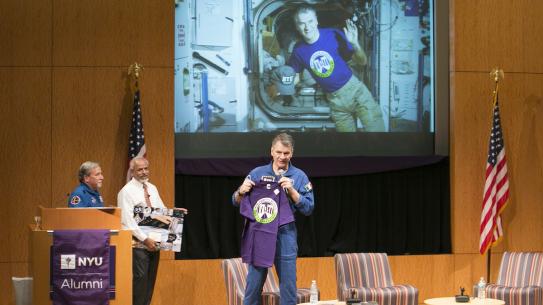High-Flying Alumni
Astronauts Charles Camarda and Paolo Nespoli Return to Their Alma Mater

From left: Dean Sreenivasan, Paolo Nespoli, '88 and '89, and Charlie Camarda '74 at "NYU in Space: The Future of Space Exploration"
Dean Katepalli Sreenivasan personally knows more than one Nobel laureate, and his academic posts have, on occasion, allowed him to meet presidents and prime ministers. “They don’t intimidate me because if I were 10 times smarter and 10 times more focused than I actually am, it’s possible that I might have a chance to attain something similar within this lifetime,” he joked. “But astronauts are a different matter. There is just no way, even with all the intelligence and focus in the world, that I could ever hope to do what Charlie Camarda and Paolo Nespoli have done.”
Sreenivasan was speaking on the occasion of a special event co-sponsored by the NYU Alumni Association and NYU Tandon that brought Camarda, who earned his undergraduate degree in aerospace engineering in 1974, and Nespoli, who holds a B.S. in aerospace engineering (’88) and an M.S. in aeronautics and astronautics (‘89), back to their alma mater in Brooklyn to speak.
The quips had started even before Sreenivasan and his distinguished guests took the stage, with Polytechnic Alumni Association (PAA) President Anthony Concolino expressing hope that the evening would be a “stellar” experience for everyone there. There was a palpable hum of enthusiasm and energy in the auditorium that seemed to call for jokes, excited laughter, and big grins. It is not every day, after all, that one gets the chance to meet men who have gone where so few ever have: Camarda logged more than 333 hours in space during his flight career, and Nespoli recently returned from a 139-day mission to the International Space Station — his third lengthy visit there.
Adding to the festive atmosphere were several young audience members, who had braved a late night to meet, as one, put it, “real, live astronauts.” Another, six-year-old Charlie Doran, proudly brandished a plastic space helmet that the pair had signed for him. (Nespoli’s autograph included advice to “reach for the stars,” proving that even astronauts are not immune to astronomy-based wordplay.) Asked what his favorite part of the evening had been, the first-grade NASA enthusiast quickly listed speaking to the astronauts one-on-one as a highlight: “Charlie told me about inventing and how to blast a rocket,” he recounted. (Camarda is, unquestionably, an expert on the topic of “inventing”; he began his career at NASA as a Research Scientist in the Thermal Structures Branch of its Structures and Materials Division, holds several patents, and was cited by Industrial Research Magazine for creating one of the top technology innovations of 1983.)
For the adults in the audience, the highlights came as Sreenivasan moderated a Q&A session that found Camarda and Nespoli thoughtfully musing on a variety of topics. At one point Nespoli looked back in amazement at his childhood and how he beat the odds: “I always told anyone who asked what I was going to do when I grew up that I’d go to the moon,” he recalled, “but really, the chances for a kid from a tiny town in Italy being able to do that were zero, probably less than zero!”
Camarda reminisced about a major mission he completed at the International Space Station, where he worked alongside a large group of fellow astronauts from Italy, Japan, and other nations. “The ISS was a massive undertaking that required the cooperation of 15 countries; it’s about the length of a football field, and we built it together, thanks to our unified vision and dreams,” he said. “When you’re working on the Space Station, you don’t care whether the person next to you is from Russia or anywhere else. You only care about how good they are at their job, because your life is in their hands and vice-versa.” Nespoli added, “In more ways than one, you don’t see borders from up there. The only one you can really see is the one between space and the atmosphere, and even that appears so thin that a breeze could blow it away.”

Both men hope that at some time in the near future, more people will get to see what they have seen. Poets, theologians, photographers, and ordinary citizens would return with new perspective, they asserted to appreciative applause.
By the end, Concolino’s wish for a stellar evening seemed to have been fully met. And while not everyone was lucky enough to leave with a signed helmet, anyone who wanted to had gotten the chance to shake the hand of an astronaut, and all had left with a heightened appreciation for the marvels of space travel.
Read more about Charlie Camarda and Paolo Nespoli.


